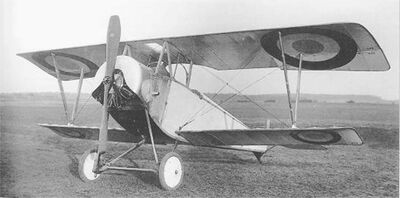The Nieuport 10 (or Nieuport XB in contemporary sources) was a French First World War sesquiplane that filled a wide variety of roles including reconnaissance, fighter and trainer.
Design and development[]
In January 1914, designer Gustave Delage joined the Société Anonyme des Etablissements Nieuport, and started working on a series of aircraft that would remain in production for the remainder of the First World War. The Nieuport 10 was the first of these and was originally designed to compete in the Gordon Bennett Trophy race of 1914. World War I caused this contest to be cancelled, and the type was developed as a military two seat reconnaissance aircraft that entered service in 1915.
The type featured a distinctive "V" strut layout. The lower wing was much smaller in area than the upper wing. The concept was intended to combine the strength, compactness and stability of the biplane's wire braced wing cell with the speed and ease of handling of the monoplane.
Many were built or converted as single-seat fighters by covering the front cockpit, and adding a Lewis Gun or Vickers machine gun either to fire through the center section of the top wing or mounted over it, firing forwards. In this form, the type was used as a fighter.
Two major types were developed from the Nieuport 10 - the Nieuport 11 Bébé - a smaller aircraft, designed from the outset as a single-seater, and the Nieuport 12 - a more powerful two-seater with a larger top wing. In addition, production was undertaken of a dedicated trainer version under the Nieuport 83 E.2 designation with detail changes. A single example of a triplane, using a Nieuport 10 airframe was built to test an unusual staggered wing concept.
Operational use[]
Many of the early French aces flew the Nieuport 10, the best known of which was Georges Guynemer, who used several Nieuport 10s, all marked "Vieux Charles". Jan Olieslagers was flying a Nieuport 10 when he became the first Belgian to shoot down another aircraft, while the first Canadian aerial victory was also scored in a Nieuport 10, by Flight Sub-Lieutenant Arthur Ince.
Variants[]
- Nieuport X.B
- Early designation distinguishing it from the earlier unrelated Nieuport X monoplane.
- Nieuport X.AV
- Company designation with the observer/gunner seated in the front and the pilot in the rear.
- Nieuport X.AR
- Company designation with the pilot seated in the front and the observer/gunner in the rear.
- Nieuport 10 A.2
- Two seat reconnaissance (Artillerie) aircraft, same as Nieuport X.AR.
- Nieuport 10 C.1
- Single-seat fighter variant. Inspired development of Nieuport 11 C.1.
- Nieuport 10 E.2
- Nieuport 10 A.2s used for training.
- Nieuport 83 E.2
- Purpose built trainer with detail modifications.
- Nieuport 10 triplane
- Testbed for triplane with unusual wing stagger.
- Nieuport-Macchi 10.000
- Italian built Nieuport 10 with many detail modifications.
- Nieuport 18 or 18 meter Nieuport
- Unofficial description of basic type based on nominal wing area of 18 square meters.
- Nakajima Army Type 甲 2 (Ko 2) Trainer
- Nieuport 83 E.2 built under licence in Japan.
- Trainer Type 2
- Siamese designation for imported Nieuport 83 E.2.
Operatory[]
- Belgian Air Force
- Brazialian Air Force
- Aeronautique Militaire
- Aeronavale
- Finnish Air Force (ex-Russian examples)
- Red Guards (ex-Russian examples)
- Corpo Aeronautico Militare
- Imperial Japanese Army Air Service
- Aeronautica Militar Portuguesa - 7 Nieuport Ni.83E-2 trainers received in 1917.
- Romanian Air Corps - one Nieuport 10 purchased in 1915, used as trainer.
- Imperial Russian Air Service - imported large numbers and built under licence.
- Imperial Russian Navy - ex Air Service aircraft.
- Serbian Air Force
- Royal Siamese Aeronautical Service
- Ukranian People's Army (One aircraft only)
- Royal Naval Air Service - early user. Note that the Royal Flying Corps did not use the Nieuport 10.
- United States Air Service of the American Expeditionary Force - used as trainers only
- Workers' and Peasants' Air Fleet (ex-Russian examples)
Survivors[]
- Two Nieuport-Macchi 10,000's survive and are on display in Italy, one at the Museo Storico Italiano della Guerra and one at the Museo della Scienza e della Tecnologia "Leonardo da Vinci", and an original Nieuport 83 E.2 that had been flown by Charles Nungesser while barnstorming in the United States shortly after the First World War, is at Old Rhinebeck Aerodrome on static display.
Specifications[]
General characteristics[]
- Crew: Two
- Length: 7.01 m (23 ft 0 in)
- Upper wingspan: 8.03 m (26 ft 4 in)
- Upper Chord: 1.61 m (5 ft 3 in)
- Wing Sweep: 2° 45'
- Lower wingspan: 7.51 m (24 ft 8 in)
- Lower Chord: 0.90 m (2 ft 11 in)
- Height: 2.85 m (9 ft 4 in)
- Wing area: 18 m2 (190 sq ft)
- Empty weight: 440 kg (970 lb)
- Gross weight: 650 kg (1,433 lb)
- Undercarriage track: 1.60 m (5 ft 3 in)
- Powerplant: 1 × le Rhône 9C 9-cylinder air-cooled rotary piston engine, 60 kW (80 hp)
- Propellers: 2-bladed fixed-pitch Régy 155 or Chauviere 2219 propeller, 2.5 m (8 ft 2 in) diameter
Performance[]
- Maximum speed: 140 km/h (87 mph, 76 kn)
- Range: 300 km (190 mi, 160 nmi)
- Endurance: 2 hours 30 minutes
- Service ceiling: 4,000 m (13,000 ft)
- Time to altitude: 15 minutes 30 seconds to 2,000 m (6,600 ft)
- Wing loading: 36.1 kg/m2 (7.4 lb/sq ft)
Armament[]
- Guns: 1 × .303 in (7.70 mm) Lewis machine gun or 7.9 mm (0.31 in) Hotchkiss mounted above the top wing
